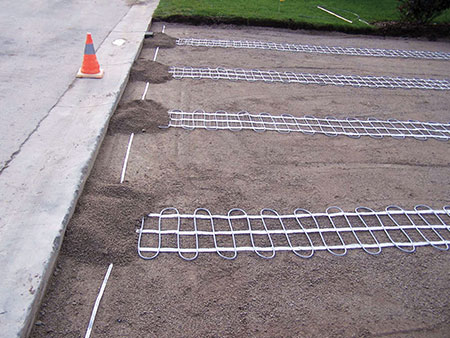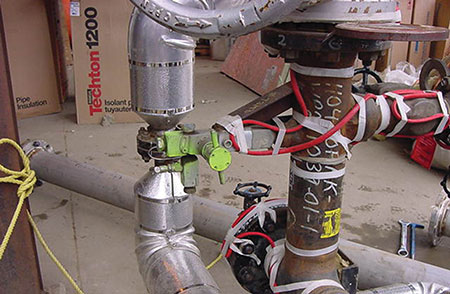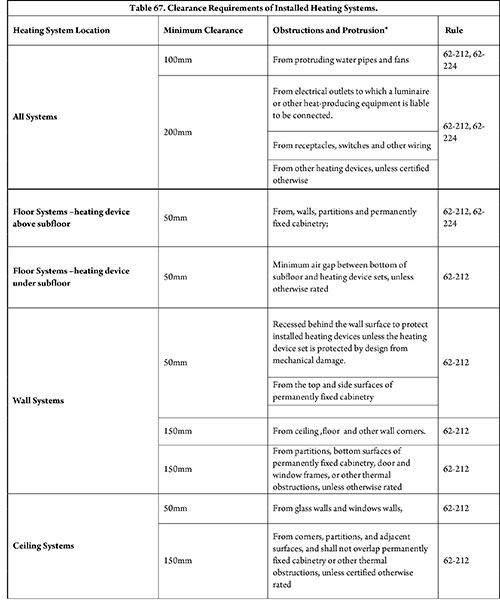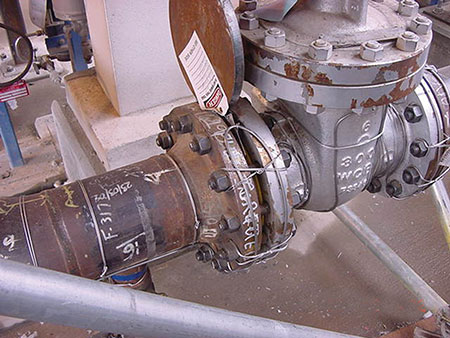This is the sixth article of series of articles detailing significant changes the Technical Committee considered for the 2015 Canadian Electrical Code Part I (CE Code). The final meeting for 2015 CE Code changes took place in June of last year. This article covers revisions on Sections 62. The rules shown in this article are limited to changes adopted by CE Code Technical Committee. It should be noted that the 2015 CE Code was published by the CSA January 1, 2015, and the information provided in this article is based solely on the observations of the writer.
Section 62
Section 62 has undergone significant changes including expansion of the title, scope and Rule 62-100 to include all electrical heating by deleting references to space and surface types of heating from the title, scope and Rule 62-100. To compliment this change a new Rule 64-102 has been inserted requiring the applicable rules of Section 62 and the manufacturer’s instructions are to be followed when installing and assembling electrical heating devices. A second subrule has also been added to this new rule moving the requirements to bond all exposed metal surfaces of heating devices and all electrically conductive coverings like sheaths, shields and braids from the 2012 CE Code Rules 62-122, 62-300, 62-302 62-308 63-310 and 62-314.

The special terminology now as Rule 64-104 has fourteen definition changes including six editorial changes, the addition of the word “electrical” to the Central unit definition limiting the definition of central unit to only electrical heating units, and the following seven new definitions:
Bare element water heater – a self-contained, factory-assembled water heater that heats water by direct contact with the uninsulated heating element wire.
Dielectric heating – the generation of heat within electrical insulating and semiconductor materials under the action of a high frequency electric field.
Heating cable – a parallel or series heating cable.
Heating cable set – a parallel or series heating cable assembled with the associated parts necessary to connect it to a source of electrical supply.
Induction Heating –the generation of heat by means of the application of magnetic field induced alternating currents to directly heat an electrically conductive object.
Impedance heating – the generation of heat by means of the application of a low AC voltage across an electrically conductive object with the resulting current directly heating that object.
Skin effect heating– the generation of heat within a ferromagnetic envelope (heat tube) by applying an AC voltage across an insulated conductor internally connected in series with the surrounding heat tube, with the resulting current heating the heat tube and indirectly heating an adjacent object.
The terminal connection requirements now in Rule 62-108 have seen editorial changes in Subrules (1), (2), and (3) replacing “heating equipment” with “heating device sets” to align the wording with established definitions. Further revisions to Subrule (3) and a new Subrule (4) replacing the 2012 CE Code Rule 62-108(1)(c), require a tap conductor of not less than 500 mm to be installed with a temperature rating as specified by the manufacturer where the point of connection exceeds 60°C.
The branch circuit requirements now in Rule 62-110 have also seen editorial changes replacing “heating equipment” with “heating device sets”, this editorial change is common throughout Section 62.
Rule 62-110 Installation of fixtures, and Rule 62-112 Fixtures as raceway, from the 2012 CE Code have been combined and renamed Installation of heating devices, and moved as a newly inserted Rule 62-210. At the same time the requirements in Item (b) of Subrule (2) and the 2012 CE Code Rule 62-122(3) to install heating devices so as to limit temperatures subjected to adjacent combustible material to 90°C were moved to a new Rule 62-112. This change also allowed for the deletion of the same requirements in existing Rule 62-304.
Rule 62-114(5) has been revised allowing an unlimited heating devices tap length where the rating or setting of the overcurrent device does not exceed the ampacity of the non-heating leads and taps, aligning this subrule with the existing allowances in Rules 14-100 and 14-104.

The ground fault requirements in Rules 62-226, 62-300 and 62-400 from the 2012 CE Code have been moved and expanded in a newly inserted Rule 62-116. In addition to the general requirement for ground fault protection with a setting sufficient to allow normal operation of the heater for electric heating cable sets, heating panel sets and fixed infrared radiant heaters of the metal-sheath glowing element type, two new subrules give examples where ground fault protection is no longer required. The first is in industrial establishments with conditions of maintenance and supervision that will ensure only qualified persons will service the installed systems and where the continued circuit operation is necessary for safe operation of equipment or processes and ground fault detection is installed. The second example is heating cable sets and panel sets connected to an ungrounded Class 1 extra-low-voltage power circuit where the Class 1 extra-low-voltage power circuit is supplied from the secondary of an isolating transformer supplied from a branch circuit operating at not more than 150 volts to ground with no direct electrical connection between the primary and secondary windings.
A new Subrule (2) has been inserted into the rule covering the demand factors for service conductors and feeders now Rule 62-118. This new subrule will permit the ampacity of the feeder conductors used solely for the supply of energy to heating device loads of a cyclic or similar nature to be based on the maximum load that may be connected at any one time.

2012 CE Code Rule 62-118 has been renumbered as Rule 62-120, and Subrule (3) that covered controls for the heating of fuel or other flammable products has been deleted as a duplication of requirements in Section 18 and product standard requirements.
The rule for the field repair, modification, or assembly of series heating cable sets, now Rule 62-126, has a new requirement for the electrical rating to be permanently marked on the cable, within 75 mm of the power connection, or on a junction box that has been provided as part of the system.
The title of Rule 62-128 has been changed from Non-heating end leads of series heating cable sets and heating panel sets to Non-heating leads of heating device sets, the rule has been rewritten with a new requirement for the raceway of non-heating leads contained within a wood base plate to be effectively protected from mechanical damage and terminate within 50 mm from the floor.
Rule 62-130 Heating panels and heating panel sets, has been deleted as rule was a duplication of definitions.
Rule 62-200 for electric space heating has a new Subrule (2) that recognizes a new Table 67. Table 67 provides minimum clearances for electric space heating systems. Table 67 is also now referenced in Rules 62-208 (formally 62-210) Location of heating cable sets and heating panel sets, 62-212 Installation of heating cable sets and heating panel sets, and 62-224 Installation of heating cable sets and heating panel sets under-floor coverings. All three of these rules have been modified removing duplications with the new Table 67.

Rule 62-204 Connections to branch circuit conductors, has been deleted. The rationale for the deletion is Subrule (1) is covered by product standard requirements and the reference to manufacturer instructions in Subrule (2) was moved to New Rule 62-102.
With the deletion of Rule 62-204, Rule 62-206 Proximity of other wiring, has now been renumbered 62-204. In addition a new item has been added allowing other wiring above heated ceilings within 50 mm above the top of the heating devices where the heating device is specifically approved and marked for a lesser clearance.
In addition to the changes already identified for Rule 62-212 Installation of heating cable sets and heating panel sets, Subrule (3) [formally (2)] has been expanded to allow cutting, any areas provided for this purpose of the heating panels and heating panel sets. The change from only allowing the nailing, or stapling through un-heated strips provided for this purpose to any area provided for this purpose was to recognise new products such as extra low voltage heating panel sets.
Rule 62-214 Heating cable sets in ceilings has been deleted as the allowance to label heating cable sets specifically intended for installation in ceilings is a product requirement and duplication.
Rules 62-216 and 62-218 have been renumbered to 62-214 and 62-216, in addition Rules 62-220 and 62-222 have been deleted. These four rules covered the installation of heating cable sets and heating panel sets in ceilings consisting of plaster, gypsum board, and other cementitious materials. The two remaining rules have been rewritten to add recognition of installations in walls and to remove product requirements, and specific installation requirements covered in the manufacturer’s installation instructions.

Rule 62-224 has been renumbered to 62-218 Installation of heating cable sets and heating panel sets under-floor coverings. The rule has also been rewritten to remove product requirements, and specific installation requirements covered in the manufacturer’s installation instructions. In addition Subrule (4) was deleted as the requirements for marking is already covered in Rule 62-212.
Rule 62-500 was moved to 62-222 Heaters for sauna rooms, with this move existing Subrule(3) covering the requirement for the temperature control to be install in accordance with the manufacturer’s instructions, was deleted as the requirement is covered in existing Rule 62-202 and new Rule 62-102.
Rule 62-306 has been renumbered as 62-304 Heating cables and heating panels installed below the heated surface, and Rule 62-312 has been renumbered as 62-308 Heating cable sets installed in or on non-metallic pipes, ducts, or vessels; both these rules have also been rewritten to remove product requirements, and specific installation requirements covered in the manufacturer’s installation instructions.
Rule 62-316 covering marking for pipes, vessels, or ducts, or vessels with electric heating has been renamed and renumbered as 62-312 Caution Labels. This change in itself is significant because, as you may recall from a previous article, caution labels are now required by new Rule 2-102 to be written in the language(s) mandated by the local authorities adopting and enforcing the CE Code. New requirements have also been added requiring caution labels to be placed in a visible location on or near associated equipment that may need to be serviced and shall be visible after installation and not more than 6 m apart on pipe and ducts, or not more than 6 m apart on tanks or vessels with not less than two labels per tank or vessel. Where the systems are not readily visible throughout the length, the permanent legible caution label is required to be on the outermost surface of the thermal insulation or cladding to indicate that they are electrically traced.

A new rule numbered as Rule 62-316 has been added for the installation of skin effect heating. This new rule will require skin effect trace heating systems to be supplied from an isolating transformer with an ungrounded secondary, and will require ferromagnetic envelopes, ferrous or nonferrous metal raceways, boxes, fittings, supports, and support hardware installed in concrete or in direct contact with the earth to be grounded at the power connection and end termination enclosure. This new rule for skin effect trace heating system will allow installation of the transformer without the ground indication required in Rule 10-106, single conductor cable to enter a metal box without provisions to address induced voltages and currents referred to in Rule 4-010, and with exception of the junction box containing the connection to the distribution wiring parts of a skin effect trace heating system such as the power, splice or terminations to be buried, embedded, or otherwise inaccessible.
Rule 64-400 has been retitled to read; 62-400 Heating cable sets and Heating Panel sets installed within pipes, ducts, or vessels. In addition, a new subrule has been added to require heating cable sets or heating panel sets installed within a non-metallic pipe, duct or vessel to be controlled by a thermostat or other suitable temperature limiting system so that it does not cause damage to the pipe, duct or vessel.
The final changes in Section 62 is the relocation of requirements from Section 26 for storage-tank water heaters in Rule 62-406, infrared drying lamps in Rule 62-408, induction and dielectric heating in Rule 62-408, and Bare element water heater in Rule 62-410.











Find Us on Socials